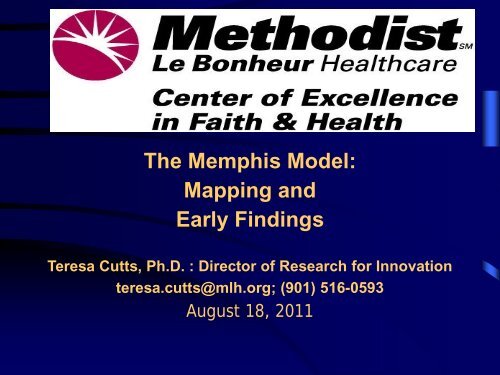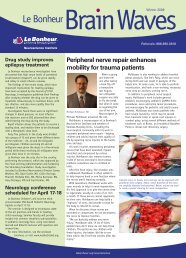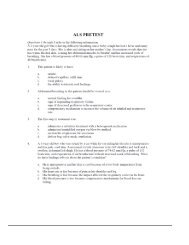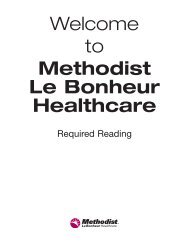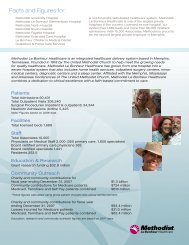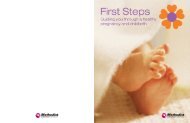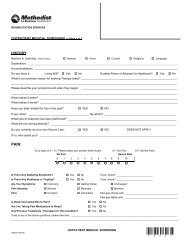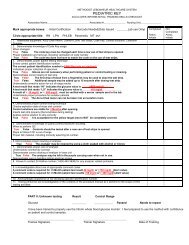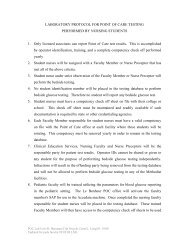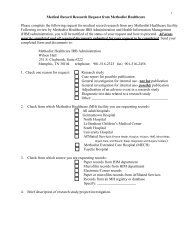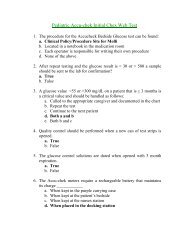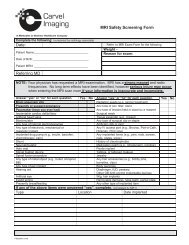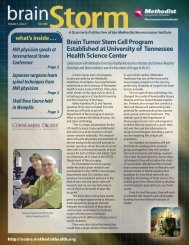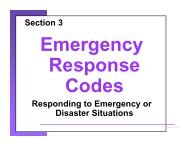The Memphis Model - Methodist Healthcare
The Memphis Model - Methodist Healthcare
The Memphis Model - Methodist Healthcare
Create successful ePaper yourself
Turn your PDF publications into a flip-book with our unique Google optimized e-Paper software.
<strong>The</strong> <strong>Memphis</strong> <strong>Model</strong>:<br />
Mapping and<br />
Early Findings<br />
Teresa Cutts, Ph.D. : Director of Research for Innovation<br />
teresa.cutts@mlh.org; (901) 516-0593<br />
August 18, 2011
<strong>Memphis</strong>: Land of Disparity<br />
Egregious disparity exists: Income, Heart<br />
Disease, Diabetes, Cancer,<br />
Suicide/Homicide, Limb Amputation
<strong>Memphis</strong>: Assets are the Blues<br />
and Lots of Church/Faith/”Soul”
• Anchors <strong>Memphis</strong> <strong>Model</strong><br />
• 7 Hospital system<br />
• $1.5 Billion budget<br />
• Provides high percentage of all indigent<br />
care in Tennessee<br />
• Owned by the UMC Arkansas, <strong>Memphis</strong>,<br />
and Mississippi Conferences
Metropolitan Inter-Faith Association<br />
(MIFA) formed in 1968: Safety Net
Church Health Center founded<br />
1987: Safety Net
Christ Community Health Service<br />
Neighborhood Clinic Opens 1995:<br />
Safety Net
Mapping: <strong>Memphis</strong> Style<br />
Our Ultimate Aim :<br />
• Build a trusted care delivery system that<br />
integrates traditional clinical care and<br />
community-based caregiving<br />
• Align and leverage religious and<br />
community health assets to improve health<br />
outcomes and access for all by 2020
An Integrated Health System<br />
Employers<br />
Education<br />
CHN Partner<br />
Church Health Center<br />
Hospice<br />
Govern<br />
ment<br />
<strong>Memphis</strong><br />
Health Ctr.<br />
nvironment<br />
Person<br />
Family<br />
Nutrition<br />
Blue<br />
Care,<br />
United,<br />
CHN Cigna Partner<br />
Sports Clubs<br />
MIFA<br />
Social Net<br />
Christ Community<br />
Pharmacy Health Services<br />
Community<br />
Health Worker<br />
Hospital<br />
Health System
Mapping: <strong>Memphis</strong> Style<br />
What do we mean by “mapping”: making<br />
visible, aligning and leveraging assets<br />
(“using what you got”….<strong>Memphis</strong> Style)<br />
Mapping shaped primarily by the patient<br />
journey (not hospital, healthcare or<br />
provider-centric)<br />
1. GIS mapping (congregational partners in<br />
CHN, safety nets, schools, agencies, others)
CHN Congregations<br />
30 Level 4<br />
176 Level 3<br />
42 Level 2<br />
86 Level 1<br />
496 trained liaisons<br />
11,385 members registered<br />
501 members from 128 congregations have been<br />
through ‘Visitation Training’<br />
212 persons have been in the ‘Care for the Dying’<br />
training<br />
78 persons were in the first Mental Health First Aid<br />
training<br />
106 persons have been in ‘Aftercare’ training
2. Participatory community<br />
based mapping to align and<br />
leverage both tangible (e.g.,<br />
faith based clinic) and<br />
intangible assets (e.g., trust)<br />
outside hospital walls
PIRHANA morphs to CHAMP:<br />
Community Engagement<br />
• ARHAP PIRHANA tool used for 11 workshops<br />
(5 most under-served neighborhoods)<br />
• Adapt to US: renamed Community Health<br />
Assets Mapping Partnership to highlight<br />
ongoing collaboration<br />
(www.memphischamp.org)<br />
• Public “ownership” and transparent sharing of<br />
data and models to nurture relationships<br />
• CHAMP model: Specialty mapping done in 2<br />
areas: eldercare, mental health; one case study
Mapping: <strong>Memphis</strong> Style<br />
3. In-hospital aligning and leveraging of case<br />
management, social work, quality, clinical<br />
informatics, marketing, policy and all<br />
divisions (e.g., CHF projects, meds) to<br />
build seamless care pathways and<br />
transitions in terms of continuity of<br />
caregiving in community (liaisons and<br />
navigators) with clinical in-house staff and<br />
Big Table partners (e.g., TennCare)
Mapping: Strengthening Webs of Trust<br />
• Leveraging CHN’s role as<br />
a “trusted intermediary”<br />
integrating with other<br />
assets for 313 faith entities<br />
(Cochrane, 2011)<br />
• Share Abundantly and<br />
Transparently<br />
• Invitational, not<br />
prescriptive…<br />
• Emergent, leadership holds<br />
open space for organic<br />
growth; well adapted to<br />
turbulence
Mapping Blended Intelligences through the<br />
Center of Excellence in Faith and Health<br />
• Traditional hospital<br />
medical and spiritual<br />
care structures<br />
(>10,000 Associates)<br />
• CHN Covenant with<br />
400 congregations<br />
• Honor and blend local<br />
and global<br />
intelligence: training,<br />
webs of learning,<br />
participatory analyses
Mapping Data Inside the Hospital<br />
-Working with Case Management, Social<br />
Work, Alliance Aftercare and Hospice to<br />
integrate their work with our CHN navigators<br />
to seamlessly build care pathways for<br />
members/patients<br />
CHN process measures through our Electronic<br />
Medical Record (EMR)<br />
-Preliminary CHN outcome and pre-post<br />
data tracked through EMR
Navigator Consult Screen
Congregational Health Network:Outcome<br />
Measures<br />
• Impact measured in hospital from<br />
Electronic Medical Record (compare<br />
CHN vs. non-CHN patient on disease<br />
care piece of “health journey”)<br />
– Decreased length of stay?<br />
– Decreased recidivism (return within 30 days)?<br />
– Decreased total costs?<br />
– Decreased mortality rate?
Member Registration: 11,385
CHN Early Outcome Data<br />
Initial Data from first 25 months of<br />
build-out and operation of CHN: Nov.<br />
2007-Nov. 2009<br />
Comparison of 473 CHN Members<br />
who came into MLH to controls who<br />
also were patients (matched on age,<br />
gender, ethnicity) in this timeframe
CHN<br />
CHN Outcome Data: 25 Months<br />
Matched Controls*<br />
N=473 473<br />
Mean Age: 60 58<br />
Gender:<br />
Female 304 304<br />
Male 169 169<br />
Ethnicity:<br />
African American 419 358<br />
European American 54 115<br />
*Matched on age, ethnicity and gender, DRG
CHN vs. Non-CHN: Admission<br />
Flow Portals<br />
250<br />
200<br />
150<br />
100<br />
50<br />
CHN<br />
Non-CHN<br />
0<br />
ED<br />
Admits<br />
MD<br />
Refer<br />
Other<br />
Hos.<br />
LTC
CHN vs. CHN Payor Mix<br />
CHN<br />
Non-CHN<br />
Medicare A&B 62% 50%<br />
Cigna FlexCare 9.1% 8.5%<br />
United HC 6% 7.3%<br />
TennCare 6% 6.1%<br />
Uninsured 2.1% 9%
CHN: Top Diagnoses<br />
Congestive Heart Failure: 23%<br />
Fibroids (intramural, uterine): 21%<br />
Uncontrolled Diabetes: 10%<br />
Coronary Artherosclerosis: 8%<br />
Schizoaffective Disorders NOS: 8%<br />
Transient Cerebral Ischemia NOS: 6.5%<br />
Other: UTI, Septicemia, Renal Failure
CHN vs. Non-CHN Length of<br />
Stay and Re-admissions<br />
50<br />
40<br />
30<br />
20<br />
10<br />
0<br />
LOS<br />
total<br />
Readmits<br />
CHN<br />
Non-CHN
CHN vs. Non-CHN: Mortality Rate<br />
3.00%<br />
2.50%<br />
2.00%<br />
1.50%<br />
1.00%<br />
0.50%<br />
0.00%<br />
Mortality<br />
Rate<br />
CHN<br />
Non-CHN
CHN vs. Non-CHN CHF and<br />
Septicemia Charges<br />
$50,000<br />
$40,000<br />
$30,000<br />
$20,000<br />
CHN<br />
Non-CHN<br />
$10,000<br />
$0<br />
CHF<br />
Septicemia
CHN vs. Non-CHN Stroke and<br />
DM Charges<br />
$120,000<br />
$100,000<br />
$80,000<br />
$60,000<br />
$40,000<br />
CHN<br />
Non-CHN<br />
$20,000<br />
$0<br />
Stroke<br />
DM
CHN vs. Non-CHN Renal Failure<br />
and Other Cardiac Charges<br />
$160,000<br />
$140,000<br />
$120,000<br />
$100,000<br />
$80,000<br />
$60,000<br />
$40,000<br />
$20,000<br />
$0<br />
Renal<br />
Failure<br />
Other<br />
Cardiac<br />
CHN<br />
Non-CHN
CHN vs. Non-CHN: Total<br />
Charges<br />
$8,200,000.00<br />
$8,000,000.00<br />
$7,800,000.00<br />
$7,600,000.00<br />
$7,400,000.00<br />
$7,200,000.00<br />
$7,000,000.00<br />
$6,800,000.00<br />
Sum of<br />
Charges<br />
CHN<br />
Non-CHN
CHN vs. Non-CHN: System<br />
Savings and Per Capita:<br />
25 months, N=473<br />
700000<br />
600000<br />
500000<br />
400000<br />
300000<br />
200000<br />
100000<br />
0<br />
Total System<br />
Savings<br />
Per Capita<br />
Savings<br />
CHN<br />
Non-CHN<br />
System Savings
Savings to Patients on<br />
Readmits*: CHN vs. Non-CHN<br />
*Based on Medicare Inpatient Deductible, net savings of<br />
$110,000<br />
$300,000<br />
$250,000<br />
$200,000<br />
$150,000<br />
$100,000<br />
$50,000<br />
$0<br />
Readmit Cost to<br />
Pt<br />
Net Savings<br />
CHN<br />
Net Savings<br />
Non-CHN
CHN vs. Non-CHN Discharge<br />
140<br />
120<br />
100<br />
80<br />
60<br />
40<br />
20<br />
0<br />
Flow Pathways<br />
Home<br />
Hhealth<br />
Rehab<br />
SNF<br />
Hospice<br />
LTC<br />
CHN<br />
Non-CHN
CHN Pre-Post Data<br />
• Compared Pre-Post Utilization Patterns in<br />
subset of 50 (N=473) CHN patients 27<br />
months before CHN started and first 27<br />
months of CHN (within subject design)<br />
• Excluded Trauma, Joint replacements and<br />
expirations in either pre or post timeframe<br />
• Excluded outliers 3 SD beyond mean for<br />
LOS
CHN Pre-Post Data: Sample<br />
Characteristics<br />
• Mean Age=64.5; Median age=65<br />
• 58% Female; 42% Male<br />
• 86% African-American; 14% Euro Am.<br />
• Major DRG: Circulatory System<br />
Disorder<br />
• Payor Mix:<br />
68% Medicare; 12% Commercial;14%<br />
TennCare/Medicaid; 6% Self-pay/uninsured
Hospital Metrics Pre-CHN Post-CHN<br />
Total admissions 159 101<br />
Admits/patient 3.2 2.0<br />
Total readmits 37 17<br />
Readmits/patient 0.74 0.34<br />
Total patient days 1,268 772<br />
Days/admit 8.0 7.6<br />
Days/patient 25.4 15.4<br />
Total charges $6,396,111 $3,740,973<br />
Average charge/admit $40,277 $37,409<br />
Average charge/patient $127,922 $74,819<br />
ER admissions 84.9% 80.2%
Statistical Tests: T-Tests<br />
Hospital Experiences Pre-FBN and Post-FB (N=50)<br />
Characteristic Pre-FBN Post-FBN P<br />
Admits/patient 3.2 2.0 .0180*<br />
Readmits/patient 0.74 0.34 .0632<br />
Days/patient 25.4 15.4 .01111*<br />
Average charge/pt $127,922 $74,819 .0034*<br />
Significant at the p
CHN Pre-Post Data<br />
• Significant utilization differences existed<br />
for patients served before and after the<br />
CHN existed<br />
– Fewer Admits, Hospital Days, Lower Average<br />
Charge/Patient<br />
– Readmits/Patient Approached Significance<br />
– Charge data were not adjusted for inflation<br />
over the full 54 month period<br />
– Cohort aged over the timeframe
CHN Pre-Post Data<br />
In this sample of CHN members:<br />
• CHN implementation decreased overall<br />
utilization of services, particularly<br />
decreased average number of admissions<br />
• Not due to inpatient clinical management<br />
differences (no change in average<br />
charge/admission)<br />
• Which leads us outside of the hospital….
What’s moving the data?<br />
• <strong>The</strong> hypothesis:<br />
– Blended intelligence<br />
• What the hospital knows about disease<br />
• What the clergy and liaisons know about life<br />
– Aligned assets leveraging Trust<br />
• Faith-driven treatment system (reimbursed)<br />
• Faith-driven healing system (non-reimbursed)<br />
– Center of Excellence is the blender<br />
• Constant data-driven innovation
CHN Outcome Data<br />
Preliminary data is promising, but<br />
needs more systematic review, more<br />
rigorous scrutiny and deeper dive.<br />
• Data sets archive at no cost<br />
• Need funds/resources to analyze data<br />
• Developing best practice models for<br />
analyzing these data via<br />
interdisciplinary models/lens
CHN Outcome Data<br />
But, imagine what can happen when<br />
we more strategically:<br />
• Deeply analyze patterns of data to<br />
drive program and education<br />
• Connect the webs of trust<br />
• Align and leverage all resources<br />
• Grow to scale (400 churches)<br />
• Flesh out patient care journeys<br />
Build care-giving and other capacity!!!!
<strong>The</strong> Center of Excellence: Blending Faith &<br />
Health<br />
• Mature Faith should always mean<br />
– “Compassionate”<br />
– Merciful<br />
– Just<br />
• But also<br />
– Smart<br />
– Innovative<br />
– Disruptively expansive
<strong>The</strong> Center of Excellence:<br />
Blending Faith & Health<br />
Relevant Science should:<br />
– Be evidence based<br />
– Result in improvement in<br />
quality of life for all<br />
– Eliminate disparity<br />
But also be:<br />
– Participatory and teachable by<br />
blended intelligence<br />
– Innovative<br />
– or grounded in life;<br />
– Disruptively useful for<br />
promoting justice…UNTIL
We Grow into the Vision:<br />
<strong>The</strong> Beloved Community


